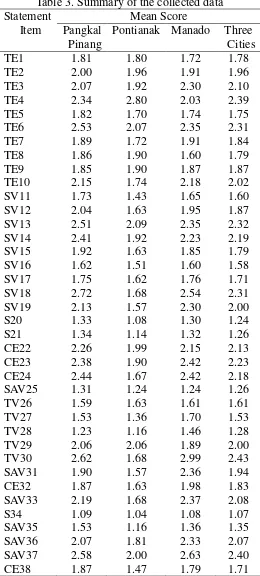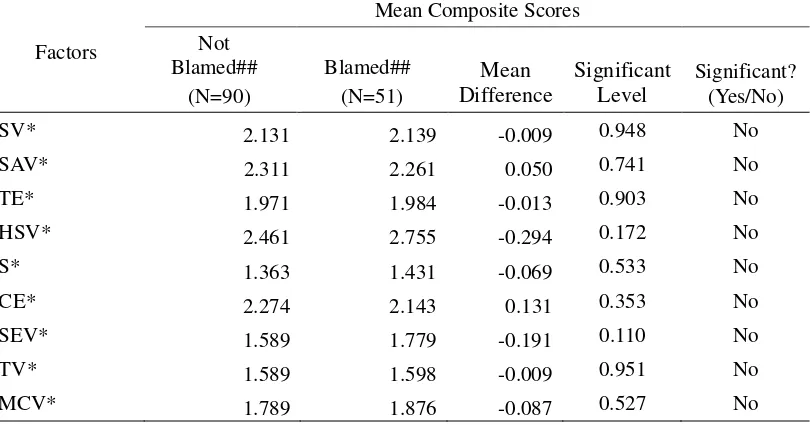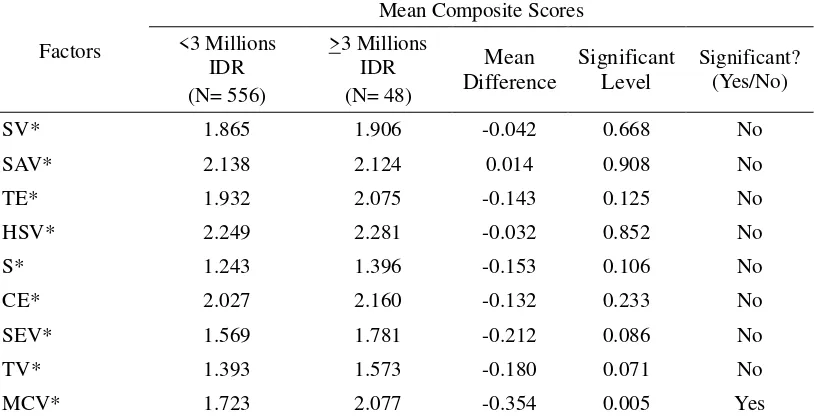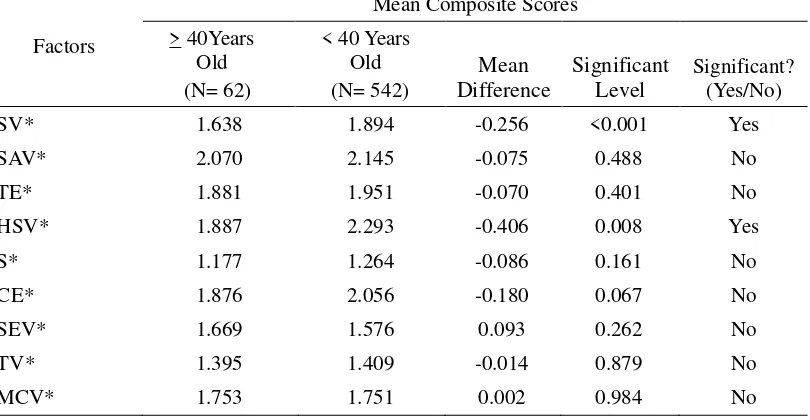The Effect of Accident History and Socio-Economic Groups on Indonesian
Motorcycle Rider Behaviour
Leksmono Suryo PUTRANTO a, Rostiana ROSTIANA b
a
Civil Engineering Department, Tarumanagara University, Jakarta, 11440, Indonesia
a
E-mail: ls.putranto@ftuntar-id.com b
Faculty of Psychology, Tarumanagara University, Jakarta, 11440, Indonesia b
E-mail: dutaindah03@yahoo.com
Abstract: This paper was based on research using Indonesian motorcycle rider behaviour questionnaires. 604 respondents from three cities (Pangkalpinang, Pontianak, Manado) were interviewed. The instrument consists of 38 statement items within nine factors, i.e. speed violations, safety violations, control errors, traffic errors, stunts, traffic violations, high speed violations, stopping errors/ violations and motorcycle carrying capacity violations. Likert scale was used from 1 (almost never) to 5 (nearly always). Generally the respondents were low risk riders. All of the composite mean values of items within each factors were less than three (a threshold between low and high risk behaviour). Respondents with accident involvement in the previous year were more frequent to conduct speed violations and stunts. Younger respondents were more frequent to conduct speed violations. Unmarried respondents were more frequent to conduct traffic errors, speed violations and stunts. Less whealthy respondents were more frequent to conduct stunts.
Keywords: Indonesian, motorcycle rider behaviour, questionnaire, errors, violations, stunts
1. INTRODUCTION
In Indonesian cities, there was increasing trend of motorcycle ownership and use to avoid congestion in the last decades. The severe congestion was due to uncontrolled land use development and unsatisfactory public transport system. Large number of motorcycle in the general traffic triggers other problems related to motorcycle rider behaviour such as unskilled rider, traffic violation, aggressive behaviour, etc. Driver behaviour questionnaire has been developed in western countries for a long period as logical consequences for car dominated countries. Such instrument can not directly be used to assess motorcycle rider behaviour. Therefore some research in England (Elliott et al, 2007), Iran (Ali et al, 2011 and Motevalian et al 2011), , Australia (Sakashita et al, 2014) and Turkey (Ozkan et al, 2012) have been done to develop motorcycle rider behaviour questionnaire (MRBQ). Slightly different approach was done In Hong Kong (Cheng and Ng, 2010). They developed specific instrument to measure violation behaviour, i.e. Chinese Motorcycle Rider Driving Violation (CMRDV).
Putranto and Anjaya (2014) propose Indonesian MRBQ. However, the items in this instrument were developed without robust theoritical basis. It was based on adaptation on theory for development of driver behaviour questionnaire, DBQ (Reason et al, 1990) research on effect of external disturbance to car driver and motorcycle rider behaviours (Putranto and Kurniawan, 2013). Elliot et al (2007) stated the difference between DBQ and MRBQ, i.e. in
the context of motorcyclists’ behaviour, it could be hypothesised that a type of behaviour
is because motorcycling is inherently much more demanding on control skills than car driving (Elliot et al, 2007).
Furthermore, MRBQ is sensitive to local customs. Items about protective clothing in England (Elliot et al, 2007) were not relevant in developing countries such as Iran (Motevalian et al, 2011) and Indonesia. In Iran, “carry passengers for money” seems to be
illegal (Motevalian e al, 2011), whilst in Indonesia “motorcycle taxi” (called as “ojek“ in local term) is a common “public transport“ although not formally mentioned in Indonesian Traffic and Land Transport Law No. 22/ 2009. Therefore the needs to develop Indonesian MRBQ is justified. The Indonesian MRBQ (Putranto and Rostiana, 2014a) was used in three cities in Indonesia (Pangkalpinang, Pontianak and Manado). Originally, 38 statement items in Indonesian MRBQ were gouped into six subscales (factors), i.e. speed violations (SV), safety violations (SAV), control errors (CE), traffic erros (TE), stunts (S) and traffic violations (TV) as used in Persian MRBQ (Motevalian et al, 2011). Effects of accident history and socio economic factors to these six factors were reported in Putranto and Rostiana (2014b). However, based on factor analysis conducted by Putranto and Rostiana (2015), nine factors were extracted. This paper is intended to evaluate effects of accident history and socio economic factors to these nine factors.
2. LITERATURE REVIEW
There were several driver behaviour questionnaire (DBQ) in some countries. One of them was Manchester DBQ (Lawton et al, 1997). Respondents were asked to rate using Likert scale from 1 (never) to 6 (almost always) their frequency to conduct aggresive, violation, erorr and lapse behaviours.
Earlier, Furnham and Saipe (1993) developed specific DBQ for driver with no previous involvement in traffic violations. Horwood and Fergusson (2000) in a study on relationship between drink driving and traffic accident within young drivers group in New Zealand used DBQ developed by Reason et al (1991) in England with necessary adjustment for New Zealand condition. Xie and Parker (2002) considered Chinese culture to modify Manchester DBQ. As a result accuracy of Chinese DBQ to predict traffic violations was improved. An example of spesific Chinese culture was identifying him/ her self as a colleague of police officers. Cultural factors were also considered by Lajunen et al (2004) when using Manchester DBQ in a research in Netherland and Finland. Sullman et al (2002) found that DBQ for four wheeler drivers can be used for truck drivers in New Zealand.
Reason et al (1990) defined violation as deliberate (though not necessarily reprehensible) deviations from those practices believed necessary to maintain the safe operation of a potentially hazardous system. Reason et al (1990) defined errors as the failure of planned actions to achieve their intended consequence. Errors can involve two psychologically distinct kinds of 'straying': the unwitting deviation of action from intention (slips and lapses); and the departure of planned actions from some satisfactory path towards a desired goal (mistakes).
in Iran. As substitutes, Persian MRBQ added two other factors, i.e. safety violations and traffic violations. In Australian MRBQ (Sakashita et al, 2014), there were four factors, i.e. errors (without distinction between traffic errors and control errors), speed violations, stunts and protective clothings (similar with safety equipments).
Instead of developing Chinese MRBQ Tiongkok, Cheng and Ng (2010) developed CMRDV (Chinese Motorcycle Rider Driving Violation). This questionnaire only consists of two factors, i.e. aggressive violations and ordinary violations.
As stated in the introduction, Putranto and Rostiana (2014a) developed Indonesian MRBQ with 38 item statements. Respondents were asked to rate using Likert scale from 1 (never) to 5 (almost always) their frequency to conduct each item statement. The followings are list of 38 statement items, beginning the two or three digits letter factor code (representing six factors in Persian MRBQ) and one or two digits statement item number:
TE1-Fail to notice that pedestrians are crossing when turning into a side street from a main road
TE2-Not notice someone stepping out from behind a parked vehicle until it is nearly too late TE3-Pull out on to a main road in front of a vehicle that you had not noticed, or whose speed
you have misjudged
TE4-Fail to notice or anticipate that another vehicle might pull out in front of you and have difficulty stopping
TE5-Queuing to turn left on a main road, you pay such close attention to the main traffic that you nearly hit the vehicle in front
TE6-Distracted or pre-occupied, you belatedly realise that the vehicle in front has slowed and you have to brake hard to avoid a collision
TE7-Attempt to overtake someone that you had not noticed to be signalling a left turn
TE8-When riding at the same speed as other traffic, you find it difficult to stop in time when a traffic light has turned against you
TE9-Ride so close to the vehicle in front that it would be difficult to stop in an emergency TE10-Run wide when going round a corner
SV11-Ride so fast into a corner that you feel like you might lose control SV12-Exceed the speed limit on a country/rural road
SV13-Disregard the speed limit late at night or in the early hours of the morning SV14-Exceed the speed limit on a motorway
SV15-Exceed the speed limit on a residential road
SV16-Race away from traffic lights with the intention of beating the driver/rider next to you SV17-Ride between two lanes of fast moving traffic
SV18-Get involved in unofficial ‘races’ with other riders or drivers SV19-Ride so fast into a corner that you scare yourself
S20-Attempt to do, or actually do, a wheelie S21-Intentionally do a wheel spin
CE22-Find that you have difficulty controlling the bike when riding at speed CE23-Skid on a wet road or manhole cover
CE24-Driver deliberately annoys you or puts you at risk
SV25-Ride when taking drugs or medications which might have effects on your riding TV26-Cross junction when traffic light is red
TV27-Riding in opposite direction of road way TV28-Riding in sidewalk
TV30-Smoking while riding
SAV31-Using helmet without chin straps or not fastening it. CE32-Carry a large carriage with motorcycle
SAV33-Carry more than one passenger with your motorcycle
S34-Have a crash with a parked vehicle and make damage to it, but escape from crash scene SAV35-Riding with an impaired motorcycle
SAV36-Riding without helmet
SAV37-Carry a passenger who have not worn helmet
CE38-Delay in noticing the car in front of you when opening door suddenly and control your motorcycle difficulty
The instrument was then used to evaluate effects of accident histroy and socio economic factors to motorcycle rider behaviours in three cities (Pangkal Pianang, Pontianak and Manado). The works reported in Putranto and Rostiana (2014b) were using six factors in Persian MRBQ to group the item statements. Mean of composite factor scores (from item statements within each factor) were calculated to represent each factor. The followings were the summary of the findings:
The respondents were relatively low risk riders as the mean of composite factor scores were less then three which is a marginal score between safe and risky behaviours.
Stunts were consistently least frequent behaviours within all groups of respondents with mean of composite factor scores less than 1.4.
Respondents involve in at least an accident within last one year tend to conduct all factors more frequently compare to respondents with no accident history within last one year. Male respondents tend to conduct speed violations and stunts compare to female
respondents.
Younger respondents from young adult age group (18-39 years old) tend to conduct more frequent speed violations compare to respondents from older age group.
Unmarried respondents tend to conduct more frequent traffic erros, speed violations and stunts compare to married respondents.
Unexpectedly, whealtier (identified from higher monthly expenditure as a proxy) respondents tend to conduct more frequent stunts compre to less whealthy respondents.
Instead of only six factors as in Persian MRBQ, Putranto and Rostiana (2015) found nine factors as follows:
SV*-Speed violations (SV11, SV12, SV15, SV16, SV17, SV19, TE6, TE10) SAV*-Safety violations (SAV31, SAV36, SAV37)
TE*-Traffic errors (TE1, TE2, TE3, CE22) HSV*-High speed violations (SV13, SV14) S*-Stunts (S20, S21, SV25)
CE*-Control errors (CE23, CE24, CE38)
SEV*-Stopping errors/ violations (TE8, TE9, TV26, S34) TV*-Traffic violations (TV27, TV28)
MCCV*-Motorcycle carrying capacity violations (CE32, SAV33, SAV35)
asked to aware that in Putranto and Rostiana (2014b) only six factors from Persian MRBQ were used for analysis.
3. METHODOLOGY
Data collection was conducted in three of five original cities in the research proposal. As the funding granted by the Directorate General of Higher Education was ony about 65% of the proposed budget, some modification was made as indicated in Table 1.
Tabel 1. Modification of number of cities and number of respondents Research Proposal Research Implementation
Cities Number of Respondents
Cities Number of Respondents Pontianak 120 Pontianak 203
Manado 120 Manado 200
Medan 120 Pangkalpinang 201 Surabaya 120
Ambon 120
Total 600 604
It can be seen that although number of cities were decrease but number of total resepondents were still above 600. Finally 604 questionnaires were completely filled. Survey in Pontianak (representing Kalimantan/ Borneo island) and Manado (representing Sulawesi island) were conducted as proposed (although number of respondents was increased). In these cities research counter parts supported by local students were available. Medan (representing Sumatra island) was removed due to inavailability of research counterpart and replaced with Pangkalpinang. The replacement city had a unique characteristics regarding motorcycle riders, i.e. balance gender ratio between male and female riders and high proportion of very young riders (younger than licensing age). Knowledge on riders in Java island can be represented by two preliminary surveys by the research team in Jakarta (Putranto and Anjaya, 2014) and (Putranto et al, 2014). Even the questionnaires used in Pontianak, Pangkalpinang and Manado was based on questionnaire improvement process after surveys in Jakarta. One of the feature of improvements was combination of favourable and unfavourable statements in the questionnaire to avoid social desirability.
Each factor then represented by the mean score of items within the factor. The mean of this composite factor scores were compared between pairs of groups of respondents based on: Monthly expenditure (>3 million IDR or <3million IDR) as a proxy of wealth level
Gender
Marital status (married or unmarried)
Age (40-60 years old representing middle adulthood or 18-39 years old representing young
adulthood in Erikson’s stages of development)
Accident history in the last one year (at least involve in one accident or not) Blamed in the accident (blamed or not blamed)
4. CHARACTERISTICS OF RESPONDENTS
According to prediction of local expert, gender ratio between male and female motorcycle riders in Pangkalpinang is about 1:1. This was not the case for other cities, i.e. about 2:1 in Pontianak and about 3:1 in Manado. The final gender ratio the sample in each city was about 55:45 in Pangkalpinang, 65:35 in Pontianak and 73:27 in Manado respectively. The overal gender ratio in three cities was 64:36.
Respondents ini Pangkalpinang were between 14 and 60 years old (mean 23.1 years old). Although respondents under licensing age (younger than 17 years old) were only five persons, in real life there was social presure to ride motorcycle in very early age. Respondents in Pontianak were between 18 and 55 years old (mean 24.7 years old). Respondents in Manado were between 16 and 67 years old (mean 26.6 years old). Respondents under licensing age were 3 persons. The overall respondents mean age in 3 cities was 24.8 years old. The other characteristics of 604 respondents filling the Indonesian MRBQ were as presented in Table 2.
Table 2. Characteristics of respondents
Characteristics Percentage of respondents Pangkal
Pinang
Pontianak Manado Three Cities
Married 18 23 35 25
From outside the province 4 5 21 10
Live in the capital of province 73 3 27 34
Monthly expenditure less than USD 80 69 73 56 65 Involve in at least an accident in last one year 83 83 62 75
5. SUMMARY OF THE COLLECTED DATA
Table 3 shows the summary of the collected data. It describes mean scores of each 38 item statement for each city and for three cities.
The respondents in three cities were relatively low risk riders because none of the mean scores were above three. The highest mean score was 2.99 (TV30-smoking while riding in Manado.
Stunts were clearly less frequent conducted. All mean scores of statement items on stunts were less than 1.35. The lowest mean score was 1.04 (S34- have a crash with a parked vehicle and make damage to it, but escape from crash scene) in Pontianak.
Table 3. Summary of the collected data
6. EFFECTS OF ACCIDENT HISTORY AND SOCIO ECONOMIC GROUPS
frequently conduct speed violations, safety violations, high speed violations, stunts, control errors and traffic violations. Table 5 shows that there were no significant difference of motorycle rider behaviours in three cities between blame/ not blamed respondents as guilty rider in the accident.
Table 4.Factors Composite Scores from Different Accident History Group Mean Difference
# accident history in the last one year
Table 5.Factors Composite Scores from Different Blamed Group Mean Difference
Factors
## blamed as the guilty rider in the accident
Table 6.Factors Composite Scores from Different Monthly Expenditure Group Mean
Table 7. Factors Composite Scores from Different Gender Group Mean Difference
Factors conduct speed violations, high speed violations and stunts more frequently. Table 9 shows that younger respondents (<40 years old) tend to conduct speed violations and high speed violations more frequently.
Table 8. Factors Composite Scores from Different Marital Status Group Mean Difference
Table 9.Factors Composite Scores from Different Age Group Mean Difference
Factors
Table 10. Difference between results from Putranto and Rostiana (2014b) and present paper Basis of Grouping Factors with Statistically Significant Mean Composite Scores Difference
Putranto and Rostiana (2014b) Present Paper
Accident history TE, SV, S, CE, SAV, TV SV*, HSV*, CE*, SAV*, TV*
The following conclusions can be made from the analysis that have been carried out in this paper, i.e.:
Stunts were less frequently conducted by respondents.
Speed violations were dominant within violation behavioru of the respondents.
Respondents involved in at least an accident in the last one year were more frequently conduct speed violations, safety violations, high speed violations, stunts, control errors and traffic violations.
Surprisingly, whealtier respondents tend to conduct motorcycle carrying capacity violations compare to less whealtier respondents.
Compare to female respondents, male respondents were more frequently conduct speed violations, high speed violations, stunts, stopping errors/ violations and motorcycle carrying capacity violations.
Compare to maried respondents, unmarried respondents tend to conduct speed violations, high speed violations and stunts more frequently.
Younger respondents (<40 years old) tend to conduct speed violations and high speed violations more frequently.
REFERENCES
Ali, M, Saeed, M.M.S., Ali, M.M., Haidar, N. (2011). Determinants of helmet use behaviour among employed motorcycle riders in Yazd, Iran based in theory of planned behaviour. Injury 42. 864-869.
Cheng, A.S., Ng, T.C. (2010). Development of a Chinese Motorcycle Rider Driving Violation Questionnaire. Accident Analysis and Prevention 42, 1250-1256.
Elliot, M.A., Bughan, C.J., Sexton, B.F. (2007). Errors and violations in relation to
motorcyclists’ crash risk. Accident Analysis and Prevention 39, 491-499.
Fergusson, D.M., Horwood, L.J., 2000. Drink Driving and Traffic Accidents in Young People. Accident Analysis and Prevention, 32, pp. 805-814.
Furnham, A., Saipe, J., (1993). Person. Individ. Diff, Vol. 14, No. 2. Personality Correlates of Convicted Drivers. Great Britain
Lajunen, T., Parker, D., Summala, H. 2004. The Manchester Driver Behaviour Questionnaire: A Cross-Cultural Study. Accident Analysis and Prevention, 36, pp. 231-238.
Motevalian, S.A., Asadi-Lari, M., Rahimi, Eftekhar, M. (2011). Validation of Persian Version of Motorcycle Rider Behavior Questionnaires. 55th AAAM Annual Conference Annals of Advances in Automotive Medicine October 3‐5, 2011.
Ozkan, T., Lajunen, T., Dogruyol, B., Yildirim, Z., Coymak, A (2012). Motorcycle accidents, rider behaviour, and psychological models. Accident Analysis and Prevention 49, 124-132. Putranto, L.S., Anjaya, I.S. (2014). Initial Developmant of Indonesian Motorcycle Rider Behavioue Questionnaire. Proceeding of 9th Asia Pacific Conference on Transportation and the Environment , 6-8 August, 2014. Colombo, Srilanka
Putranto, L.S, Kurniawan, J. (2013). 13th International Conference on Quality in Research (QiR). The Effect of External Disturbance to Car Driver and Motorcycle Rider Behaviour. Yogyakarta, Indonesia, 25-28 June 2013
Putranto, L.S., Rostiana (2014a). Studi Penanganan Perilaku Berisiko Pengemudi Sepeda Motor Indonesia. Research Report (Unpublished).
Putranto, L.S., Rostiana (2014b). Pengaruh Faktor Sosial Ekonomi dan Riwayat Kecelakaan terhadap Perilaku Pengemudi Sepeda Motor Indonesia. Proceeding of 1st Andalas Civil Engineering Conference, 27 November2014. Padang, Indonesia.
Putranto, L.S., Setyarini, N.P.S.E., Rostiana, Bunawan, R. (2014). Proceeding of the 16th International Symposium of Inter University Transportation Study Forum. Motorcycle Rider Behaviour of Tarumanagara University Lecturer and Employee. Jember: Universitas Jember, Indonesia.
Reason, J., Manstead, A., Stradling, S., Baxter, J., Campbell, K. (1990). Errors and violations on the road: a real distinction? Ergonomics 33, 1315-1332.
Skashita, C. Senserrick, T, Lo, S. Boufous, S. De Rome, L., Ivers, R. (2014). The Motorcycle Rider Behavior Questionniare: Psychometric properties and application amongst novice riders in Australia. Transportation Research Part F 22, 126-139.
Sullman, M.J.M., Meadows, M.L., Pajo, K.B. (2002). Transportation Research Part F 5. Aberrant driving behaviours amongst New Zealand truck drivers.




